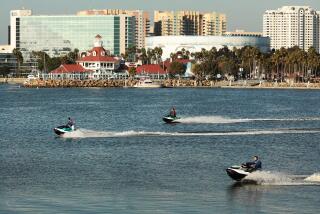Noise Monitors Go Head-to-Head at K-Boat Races
LONG BEACH — Marine Stadium was the scene of two separate battles last weekend.
On the water, traveling at speeds in excess of 100 m.p.h., a group of 1,500-horsepower flat-bottom K-boats competed in a race for a $10,000 prize.
At two locations on shore, meanwhile, a battle of a more subtle nature unfolded. There, hundreds of yards apart, a pair of decibel meters dueled head-to-head in a war of measurements. And nobody seemed very surprised when the readings came out radically different, pitting residents against city officials on the question of whether city noise limits were being adequately enforced.
Mounted on the balcony deck of a private residence overlooking the stadium, a mile-long channel stretching south from Colorado Lagoon to the Long Beach Marina, a meter operated by a group of disgruntled homeowners registered 65 instances in two days in which boats exceeded the 85-decibel limit the city has vowed to enforce. About 10% of the time on the first day, the residents said, their meter was reading 85.5 decibels or above. And in one instance, they said, the meter registered 102 decibels--more than the sound of heavy city traffic.
Up at the northwest end of the stadium where two city officials were taking noise readings of their own, however, the story was different. There, according to Michael Little, an operations officer for the city’s marine bureau, only seven instances were registered in which boats exceeded the 85-decibel limit. In each case, he said, the offender was disqualified from racing for the rest of the day.
The reason for the conflicting measurements was obvious to both sides. While the homeowners took their readings from a crowded spot directly overlooking the straightaway, where the boats accelerate to full speed, the city had placed its meter hundreds of feet from the nearest engine at a wide-open point where most of the boats decelerate to round the bend.
“It doesn’t take a rocket scientist to figure out that the noise levels there would be a lot less than at our house,” said Robbie Soltz, one of the complaining residents.
Allowed Little: “It might seem sneaky. But when (the sound limit) was first imposed, it was the people down at that (northwest) end of the stadium who had the most political clout.”
Indeed, said Councilwoman Jan Hall, whose district includes Marine Stadium, the location of the city’s official sound monitoring station was “scientifically” determined back in 1978 when the City Council first adopted the 85-decibel noise limit. That action followed a year of lobbying by residents of nearby Alamitos Heights, an affluent neighborhood to the north and west of the stadium. And it ushered in a decade of relative silence during which speedboat racers, unable to comply with the sound limit, stayed away in droves.
More Efficient Mufflers
All that began to change recently with the advent of sophisticated new mufflers capable of greatly reducing the noise levels emitted by speedboats. Equipped with such mufflers, speedboat racers have begun returning to the Long Beach stadium, first last November, then again last weekend.
But if boat technology has changed in 10 years, so has the makeup of the neighborhood abutting the stadium on its south side. While many residents still recall with fondness the days when they used to watch the action from their balconies and patios, others have moved in since the racing disappeared. And it is from this group that most of the complaints have arisen now that the racing has resumed.
Among other things, the disgruntled residents have circulated petitions and written letters to the city demanding an environmental impact study on what they consider the stadium’s “new” use. Last weekend’s monitoring, they said, was an attempt to prove that even the city’s own 85-decibel limit was not being fully enforced.
But city officials say the stadium use is not new and that the noise limits are being observed. What’s more, says the marine bureau’s Little, the resumption of racing at Marine Stadium is good for Long Beach. “It’s a great outlet for people to come down and enjoy themselves,” he said. In addition to enhancing the city’s image as a recreational center, Little said, the races contribute to the city’s general fund by attracting out-of-town visitors who pay a bed tax for staying in local hotels. And part of the $1,500 weekend rental fee the city collects for use of the stadium, he said, goes toward cleaning area beaches.
“People are just jumping up and down happy,” is how Little describes the reaction of most area residents to the resumption of racing at the stadium.
Shares Assessment
That assessment is shared by Rob Kolbeck, promoter of last weekend’s race, sponsored by Sundown Marine of Huntington Beach. “We got a totally positive response,” he said of the event, which drew an estimated 6,000 spectators.
Resident Soltz, meanwhile, said she is considering filing a lawsuit on behalf of homeowners who do not share in the alleged general euphoria. “I was surprised at the insensitivity of the city’s approach,” she said.
In the meantime, Kolbeck, bolstered by what he reads as the community’s positive response, is planning another race for the weekend of June 4 and 5. “Those houses were built up against the stadium with the knowledge that there would be races there,” he said. “These people came after the fact; if they bought those houses, they will have to live with the sounds.”
More to Read
Sign up for Essential California
The most important California stories and recommendations in your inbox every morning.
You may occasionally receive promotional content from the Los Angeles Times.










